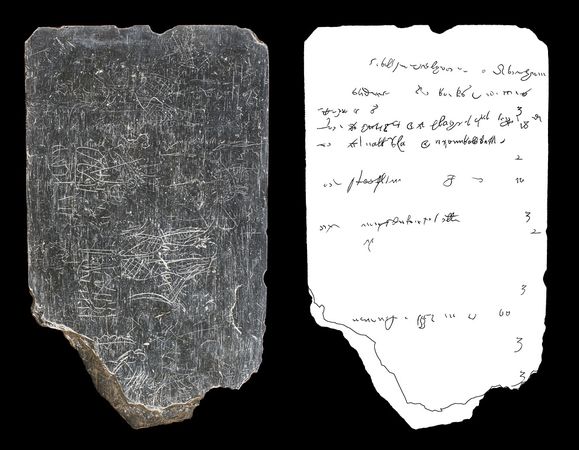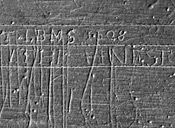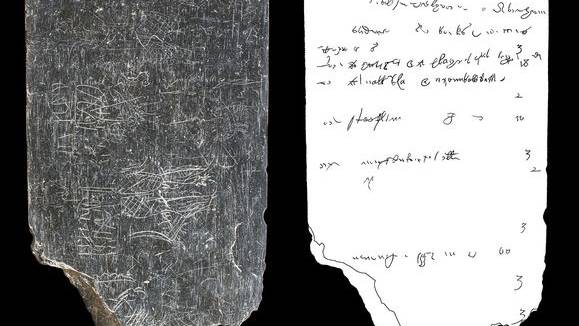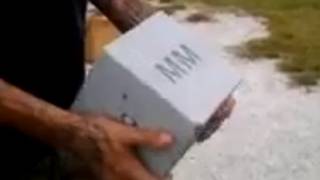Mysterious Jamestown Tablet an American Rosetta Stone?
Source: news.nationalgeographic.com

With the help of enhanced imagery and an expert in Elizabethan script, archaeologists are beginning to unravel the meaning of mysterious text and images etched into a rare 400-year-old slate tablet discovered this past summer at Jamestown, Virginia, the first permanent English settlement in America.
 Digitally enhanced images of the slate are helping to isolate inscriptions and illuminate fine details on the slate—the first with extensive inscriptions discovered at any early American colonial site, said William Kelso, director of research and interpretation at the 17th-century Historic Jamestowne site (Jamestown map).
Digitally enhanced images of the slate are helping to isolate inscriptions and illuminate fine details on the slate—the first with extensive inscriptions discovered at any early American colonial site, said William Kelso, director of research and interpretation at the 17th-century Historic Jamestowne site (Jamestown map).The enhancements have helped researchers identify a 16th-century writing style used on the slate and discern new symbols, researchers announced last week. The characters may be from an obscure Algonquian Indian alphabet created by an English scientist to help explorers pronounce the language spoken by the Virginia Indians.
"Just like finding the Rosetta Stone led to a better understanding of the Egyptians, this tablet is beginning to add significantly to our understanding of the earliest years at Jamestown," Kelso said. It conveys messages about literacy, art, symbols and signs personally communicated by the colonists who used it, he explained.
"What other single artifact has been found that has so much to tell?"
Both sides of the scratched and worn 5-by-8 inch (13-by-20 centimeter) tablet are covered with words, symbols, numbers, and drawings of people, plants, and birds that its owner or other users likely encountered in the New World.
There are differences in the style of handwriting, which may mean that more than one person used the tablet as a sketch pad and possibly for writing rough drafts of documents, Kelso noted.
Enhanced Images
To help researchers decipher the inscriptions, curators at the Smithsonian Institution’s Museum Conservation Institute recently produced enhanced images of the slate through a process known as reflectance transformation imaging.
Hundreds of high-resolution digital images were taken of the tablet using multiple angled lights to exaggerate the appearance of grooves in the slate’s surface—like watching the sun rise and set on an object.
The images on the slate are difficult to see with the naked eye, because they are the same dark gray color as the slate and they overlap.
Colonists would have written on it with a pencil made of slate that left white marks. The marks could be wiped off, but fortunately for archaeologists today, the pencil had a sharp point that also left scratches on the tablet that couldn’t be erased completely. As a result, there are layers upon layers of inscriptions.
Elizabethan Script Analysis
Based on an initial examination of images, Heather Wolfe, curator of manuscripts and an expert in Elizabethan script at the Folger Shakespeare Library in Washington, D.C., thinks that much of the cursive writing on the slate appears to be written in secretary hand, the main form of cursive handwriting taught in England during the early 16th and 17th centuries.
"Many of the letter forms are different from the forms used today. You need special training to understand them," Wolfe said.
So far, the words "Abraham" and "book" appear to be visible, and she has been able to identify some individual letters. She hopes to be able to decipher more of the text using the images taken by the Smithsonian that provide finer details. Unfortunately only a portion of the text survived; parts of letters and some words are missing.
Wolfe explained that the practice of using erasable slates for drafting music and teaching the alphabet and spelling goes back to the 16th and 17th centuries, but they were so fragile, they usually broke.
Finding a largely intact slate like this one is "very rare," Wolfe said. "The slate provides a unique window into a practice that we’ve known about, but that we haven’t seen before."
Algonquian Pronunciation Symbols
Historic Jamestowne’s Kelso said the enhanced images also revealed two symbols that are similar to characters in a phonetic Algonquian alphabet invented in 1585 by Thomas Hariot.
The English scientist participated in the expedition to establish an ill-fated colony on Roanoke Island—in what is now North Carolina—for his patron, Sir Walter Raleigh, that same year.
It wasn’t until after archaeologists had discovered the slate that Kelso was made aware of the 36-character alphabet by a researcher attending one of Kelso’s lectures. The alphabet survives as a manuscript in the library of the Westminster School in London.
Kelso said there are also documented references to a dictionary of the Algonquian language, which some scholars think Hariot developed, since he had had the opportunity to learn the language from Native Americans who returned to England with the explorers. Fire destroyed the dictionary in 1666, and there are no surviving copies, he said.
"When I found out about it," Kelso said, "the probability that the European explorers likely showed up at Jamestown with bilingual dictionaries, ready to communicate with the Indians, made perfect sense," he said.
Other details revealed through the enhanced images will help researchers determine the sequence of the inscriptions.
"In a way, it’s a mini-archaeology site. If one groove cuts across another groove, you can tell which one was the most recent," Kelso said.
Smithsonian curators also used x-ray fluorescence to identify the chemical composition of the slate and create a geological profile. The results will be compared to slate samples from different locations in Europe to learn the origin of the slate.
Found in John Smith’s Well
Archaeologists discovered the slate in the center of James Fort in a well most likely built in 1609 under the direction of Capt. John Smith, a founding leader of Jamestown, which was established in 1607.
When the water in the well went bad, colonists used the well as a trash pit. They discarded the tablet and thousands of other artifacts during the winter of 1609-10, called the Starving Time.
Near the slate, archaeologists found butchered bones from horses and dogs, which may date to the same period, when the fort was under siege and colonists resorted to eating their domestic animals. Only about 60 of 200 people survived the winter.
Archaeologists reached the bottom of the 14-foot-deep (4.2-meter-deep) barrel-lined well in December. They are currently analyzing, conserving and restoring the rest of the enormous and unprecedented collection of artifacts. The analysis is expected to lead to a better understanding of the colony’s difficult early years.
Read the full article at: news.nationalgeographic.com
Photograph courtesy Smithsonian Museum Conservation Institute and Preservation Virginia
Also tune into:
John Kale - The Masonic Star Map of Charleston
John Kale - The Masonic Star Map of Charleston Continued
Wayne Herschel - The Forbidden Star Map & Masonic Tracing Board
Freeman - The Esoteric Adventures of Freeman
Cort Lindahl - Geomantic Information Systems
Jay Weidner - Future, Freemasonry, Franklin & Films
Scott Wolter - The Kensington Rune Stone






















